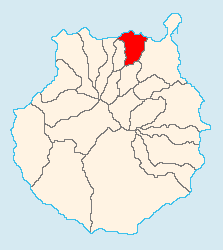Arucas, Las Palmas
Arucas | |
|---|---|
Municipality | |
 | |
 | |
| Autonomous region | Canary Islands |
| Province | Las Palmas |
| Island | Gran Canaria |
| Area | |
| • Total | 33.01 km2 (12.75 sq mi) |
| some sources list 33.39 km² | |
| Elevation | 240 m (790 ft) |
| Population (2004) | |
| • Total | 33,701[1] |
| Municipal code | E-35006 |
Arucas is a Canary Islands municipality in the province of Las Palmas. It is situated in the north of Gran Canaria. Arucas is a suburb of Las Palmas city.
Arucas's area is 33.01 km² with a population of about 33,701 (ISTAC, 2003) and its density is 1,009.31/km² making the second most populated municipality in the island.
Arucas is situated in the mountains and the valleys, the farmlands cover parts of Arucas, the mountains cover the southern part and the valleys in the northern part. Farmlands are within the coastline, the Atlantic Ocean lies to the north. Arucas is located W of Las Palmas de Gran Canaria and serves an interchange with the GC2, N of the GC30, E of Gáldar and NW of Telde. The main industry are agriculture, businesses and tourism.
| Year | Pop. | ±% |
|---|---|---|
| 1991 | 26,974 | — |
| 1996 | 29,179 | +8.2% |
| 2001 | 32,466 | +11.3% |
| 2002 | 32,917 | +1.4% |
| 2003 | 33,449 | +1.6% |
| 2004 | 33,701 | +0.8% |
Sites of interest


The Church of San Juan Bautista is the leading architectural and social monument in the municipality. It was built entirely in Arucas stone by local master masons, and it dates from 1909. Apart from the wealth of the carved stone columns and column heads, there are also some beautiful stained glass windows, the works of Canary Island painter Cristobal Hernandez de Quintana, and an extraordinary carving of the Reclining Christ, by Manuel Ramos.[3] To the north is the Montaña de Arucas which is thought to be the area where courageous Doramas the Guanche leader was killed in 1481 by Pedro de Vera in the Battle of Arucas. Arucas is known for the production of rum.[4]
History and Information
Arucas was rebuilt in 1480 after being completely destroyed in 1478. Since the 15th century, the main crop of the Arucas area was sugar cane. Rum was produced here long before sugar plantations were cultivated in Cuba. One of the main features of modern-day Arucas is its rum factory.[5] Arucas boomed with the demand for cochinilla (a beatle feeding off cactus pear, crushed to produce red dye) in the second half of the 19th century.
Other
Arucas has schools, lyceums, gymnasia, churches: the famous Arucas cathedral, a post office and squares (plazas). There is also a Botanical Garden, the Jardín de la Marquesa de Arucas.
- Church of San Juan Bautista (also vulgarly known as Catedral de Arucas due to its big size) built entirely in Arucas stone by local master masons, and it dates from 1909 (initial configuration from the 17th century). Apart from the wealth of the carved stone columns and column heads, there are also some beautiful stained glass windows, the works of Canary Island painter Cristobal Hernandez de Quintana, and an extraordinary carving of the Reclining Christ, by Manuel Ramos.[3]
- Jardín de la Marquesa de Arucas - Botanical Garden in Arucas.
See also
References
- ^ http://www.gobiernodecanarias.org/istac/
- ^ "Jardín de la Marquesa website". Jardindelamarquesa.com. Retrieved 2013-03-12.
- ^ a b "Discover Arucas". Grancanaria.com. Retrieved 2013-03-12.
- ^ "Gran Canaria Tourism Guide - Arucas". Iknow-canaryislands.co.uk. Retrieved 2013-03-12.
- ^ "Arucas". Justgrancanaria.com. Retrieved 2013-03-12.


